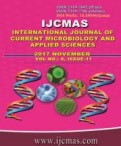


 National Academy of Agricultural Sciences (NAAS)
National Academy of Agricultural Sciences (NAAS)

|
PRINT ISSN : 2319-7692
Online ISSN : 2319-7706 Issues : 12 per year Publisher : Excellent Publishers Email : editorijcmas@gmail.com / submit@ijcmas.com Editor-in-chief: Dr.M.Prakash Index Copernicus ICV 2018: 95.39 NAAS RATING 2020: 5.38 |
A field experiment was conducted during kharif 2009 at the Crop Research Farm, Department of Agronomy, Naini Agricultural Institute, Sam Higginbottom University of Agriculture, Technology & Sciences, Allahabad, Uttar Pradesh, India to study the effect of different spilt doses of nitrogen (N), Leaf Colour Chart (LCC) based nitrogen management on growth and yield of transplanted rice. Nitrogen management practices were consisted of application of 150 kg N ha-1 in different split doses (Two equal splits – 1/2 at basal, 1/2 at active tillering, Three splits – 1/2 at basal, 1/4 at active tillering, 1/4 at panicle initiation, Three splits 1/3 at basal, 1/3 at active tillering, 1/3 at panicle initiation, Four splits – 1/4 at basal, 1/4 at active tillering, 1/4 at maximum tillering, 1/4 at panicle initiation, and Four splits – 1/3 at basal, 1/3 at active tillering, 1/6 at maximum tillering, 1/6 at panicle initiation), LCC 3 and LCC 4 with 20 kg N ha-1 as basal with 23 and 28 kg N ha-1 respectively based on weekly reading. The results revealed that nitrogen management at LCC value of 4 (4 splits; 132 kg N ha-1) produced significantly higher plant height (113.4 cm), crop and relative growth rates 21.84 g m-2 day-1 and 0.072 g g-1 day-1 respectively, effective tillers hill-1 (14.60), grains panicle-1 (162.13) and grain yield (60.70 q ha-1) than LCC value of 3 (4 splits; 112 kg N ha-1) that produced grain yield of (42.30 q ha-1) as well as other nitrogen management treatments (N at 150 kg ha-1). Thus, considering the influence of LCC based nitrogen application on productivity and profitability of rice and saving of fertilizer N. It is concluded that the LCC offers gigantic opportunities to increase N use efficiency, rice yield and net return for farmers in Allahabad region of Eastern Uttar Pradesh.
 |
 |
 |
 |
 |